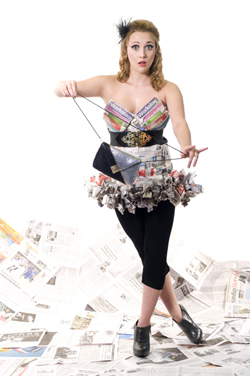Dal student Josh Boyter has a lot on his plate.
Having obtained combined honours in International Development Studies (IDS) and Social Anthropology, he is now pursuing his IDS Masters, but still finds time for photography.
Mr. Boyter’s work has appeared in publications and advertising for Eastern College, Dal News, and various other local restaurants and companies. On top of everything, he has managed to keep his artistic visions in focus, designing his own exhibits around fashion photography, and displaying his pieces through Visual Arts Nova Scotia and the Hub.
The underside of fashion
Mr. Boyter hopes to develop a large exhibition for Halifax, Toronto, and Montreal in which he applies his social anthropology background to exploring the negative aspects of fashion. He refers to this project as “the underside of fashion” and has been working with special effects make-up artists to create alter realism.
“I want to look at themes that we don’t normally understand or even see,” he says. “The image is only one small aspect of what you see, and you only see ten percent of what is actually being portrayed.”
When visiting Mr. Boyter in his studio one day, I discovered him photographing a model who was wearing a dress that appeared to be physically stitched into her skin. While the shocking image was courtesy of a make-up artist, Mr. Boyter hoped to draw attention to the fact that many runway and shop-front dresses are “false” garments that are sewn closed with the models inside, or pinned onto mannequins.
Other issues that he wishes to draw attention to are drug culture and plastic surgery. Mr. Boyter believes that there is a lot more at play in the fashion world’s deceptive images than just make-up, and he wants to use the illusory nature of photography to highlight that “images can look completely different than real life.”
Reuse, Recycle, Redesign
Mr. Boyter enjoys photographing his own creations, which is easy considering that he also designs clothes. “I like to work with my hands,” he explains. He makes some of his clothing pieces from scratch, while others are reconstructed from previously existing items.
 As part of his current project, Mr. Boyter has constructed clothing out of recycled materials. He calls the pieces “wearable sculptures,” and has even been able to apply his metal-working background in creating them. “It’s necessary to become comfortable being uncomfortable and to try new things,” notes Mr. Boyter, when discussing his trash-to-high-fashion designs.
As part of his current project, Mr. Boyter has constructed clothing out of recycled materials. He calls the pieces “wearable sculptures,” and has even been able to apply his metal-working background in creating them. “It’s necessary to become comfortable being uncomfortable and to try new things,” notes Mr. Boyter, when discussing his trash-to-high-fashion designs.
For one piece, Mr. Boyter has used medical tools, including an arm piece designed from forceps. His art requires patience, as he places great importance on the quality and detail of his work, and carefully plans out each complex shot, only photographing one piece for his exhibits at a time.
He also makes, as he puts it, “some more commercially viable pieces” which are sold in local stores on consignment.
From darkroom to classroom
Mr. Boyter says his university education has helped him develop business plans for his photography and fashion design work. Further intertwining art and academics throughout his degree, he has written papers for publication on the subjects of his artistic projects, most recently focusing on the dangers of fashion’s portrayal in photography and the use of international development in advertising campaigns.
In the future, Mr. Boyter hopes to work in conflict zones, using photography for conflict resolution and peace. He would also like to consult for larger firms to make more ethical decisions in regards to the marketing strategies used to sell clothing.
“You have to move quickly with what is happening [in the world],” he says, “and open your mind to inspiration.”
You can keep an eye out for Mr. Boyter’s work in Halifax’s Viewpoint Contemporary Photography Gallery and visit his website at www.joshboyter.com.

